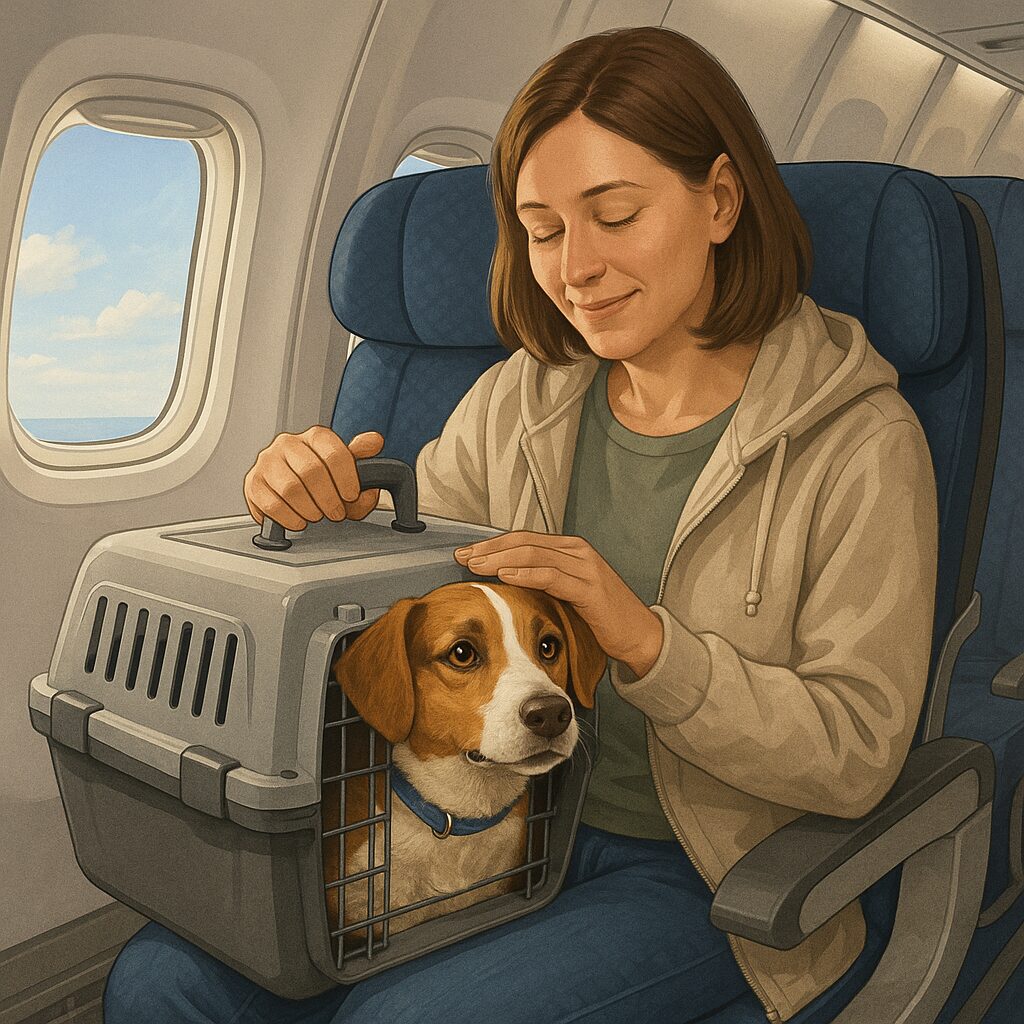Flying with your dog can be a rewarding experience — whether you’re relocating, going on vacation, or visiting family. But air travel involves careful planning and preparation to ensure your dog’s safety and comfort. Unlike car trips, flying includes unique challenges such as cabin restrictions, temperature concerns, airline rules, and potential anxiety for both you and your dog.
In this article, you’ll learn everything you need to know to safely travel with your dog on a plane, from choosing the right airline and preparing documents to crate training and easing stress.
Know the airline’s pet policy
Before booking your flight, check the specific pet policy of the airline. Rules can vary significantly between carriers, and even between domestic and international flights.
Key factors to confirm:
- Whether pets are allowed in the cabin or cargo hold
- Size and weight limits for in-cabin travel
- Types of approved carriers or crates
- Health certificate and vaccination requirements
- Breed restrictions (especially for brachycephalic dogs)
- Seasonal embargoes for pets in cargo (often during extreme temperatures)
Always call the airline directly to double-check the latest rules and reserve your dog’s spot — many airlines have limited in-cabin pet slots.
Cabin vs. cargo: which is safer?
In-cabin travel is generally safer and less stressful for dogs, especially small breeds that fit under the seat in a carrier.
Pros of in-cabin travel:
- Constant supervision
- Controlled temperature
- Less chance of mishandling or delays
However, if your dog is too large for in-cabin travel, cargo may be the only option. When flying cargo:
- Choose non-stop flights with no layovers
- Fly during cooler times of day or year
- Use a sturdy, IATA-approved crate
- Label the crate with clear contact info and “LIVE ANIMAL” stickers
- Attach food, water, and absorbent padding inside
If possible, consider pet-specific airlines or cargo services that specialize in animal transport.
Prepare the proper documents
Many airlines — and most countries — require documentation for traveling dogs. Common documents include:
- Health certificate from your vet (usually issued within 10 days of travel)
- Rabies vaccination records
- Microchip registration (especially for international travel)
- Import permits for certain destinations
- Airline travel form or waiver
Check with your destination country’s regulations as well — some places have strict quarantine policies.
Crate or carrier training
If your dog isn’t used to a crate or travel carrier, start training weeks in advance of your flight.
Steps to crate train:
- Choose a comfortable, airline-approved crate
- Let your dog explore it at home with the door open
- Feed meals or offer treats inside the crate
- Gradually increase the amount of time your dog spends inside
- Take short car rides to simulate travel movement
A dog that’s comfortable in their crate will handle the flight more calmly and safely.
Pack a travel kit for your dog
Prepare a dedicated bag with the essentials:
- Travel crate or soft carrier
- Leash and harness
- Portable water bowl and water
- Small portion of food or treats
- Absorbent pads or blankets
- Favorite toy or calming item
- Cleaning wipes and poop bags
- Any medications, with instructions
Keep essentials in your carry-on if your dog is flying in the cabin.
Manage food and water before the flight
Avoid feeding your dog a large meal within 4–6 hours of departure to reduce nausea and bathroom needs. Offer water up until boarding, and don’t restrict hydration during the flight.
If flying cargo, freeze a small water dish so it slowly melts — this helps prevent spills while still offering water access.
Use calming strategies
Some dogs get anxious with all the unfamiliar sounds, smells, and movement involved in airports and airplanes.
To reduce stress:
- Give your dog plenty of exercise before heading to the airport
- Play soft music or white noise near the crate at home during training
- Use a pheromone spray or calming collar (like Adaptil)
- Bring a blanket or shirt with your scent
- Ask your vet about natural supplements for calming
Avoid sedatives, unless specifically approved by your vet — they can affect breathing and increase risk during air travel.
Airport navigation tips
- Arrive early, but not too early (2–3 hours before departure)
- Use the designated pet relief areas at the airport
- Keep your dog securely leashed at all times
- Be patient and keep your energy calm — dogs pick up on your mood
- Inform staff if you need assistance boarding with your pet
Try to board last if possible to reduce waiting time in a confined space.
Post-flight recovery
Once you land:
- Offer your dog water and a bathroom break as soon as possible
- Monitor for signs of stress, dehydration, or fatigue
- Resume regular feeding slowly
- Let your dog explore the new space gradually
Give your dog time to adjust to the new environment and maintain routines as best as you can.
A smooth flight starts on the ground
Air travel with dogs requires extra effort — but it’s absolutely doable with proper planning. Whether your pup is in the cabin beside you or flying in cargo, your preparation makes all the difference in how they experience the trip.
By choosing the right airline, preparing the right gear, and supporting your dog physically and emotionally, you can make air travel safe and manageable — and even enjoyable.

